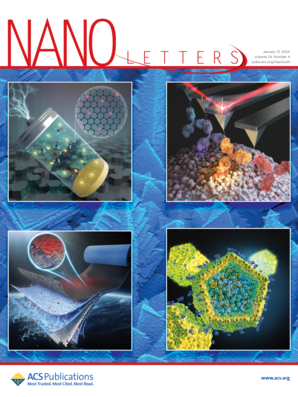Deciphering the Impact of Graphene Oxide Incorporation on Structural, Chemical, and Electrochemical Properties of Na2Fe(SO4)2 Cathode Materials
IF 9.6
1区 材料科学
Q1 CHEMISTRY, MULTIDISCIPLINARY
引用次数: 0
Abstract
The performance of polyanionic Na2Fe(SO4)2 (NFS) cathode materials is hindered by their low electronic conductivity and is correlated to their structural and chemical instability. Herein, we incorporated graphene oxide (GO) to modify NFS materials, which can build a carbon layer on the surface and alleviate Na6Fe(SO4)4 phase formation and Fe2+ oxidation in the lattice. Meanwhile, the performance of NFS materials has been significantly improved, such as the capacity retention showing an increase from 56% to 87% after 200 cycles at 0.5 C with GO incorporation. Soft X-ray absorption spectra (sXAS) reveals that the bulk has higher reversibility of the reaction between Fe2+ and Fe3+ than the surface during cycling, which indicates the origin of cycling instability of NFS materials. These findings provide new insights into surface modification for the development of high performance NFS cathodes.

解读氧化石墨烯掺杂对 Na2Fe(SO4)2 阴极材料的结构、化学和电化学特性的影响
聚阴离子Na2Fe(SO4)2 (NFS)正极材料的性能受到其低电子导电性的影响,并与其结构和化学不稳定性有关。在此,我们将氧化石墨烯(GO)加入到NFS材料中,可以在表面形成碳层,减轻晶格中Na6Fe(SO4)4相的形成和Fe2+的氧化。同时,加入氧化石墨烯后,NFS材料的性能得到了显著改善,在0.5 C下循环200次后,容量保持率从56%提高到87%。软x射线吸收光谱(sXAS)显示,在循环过程中,Fe2+和Fe3+反应的可逆性高于表面,这表明了NFS材料循环不稳定性的根源。这些发现为开发高性能NFS阴极的表面改性提供了新的见解。
本文章由计算机程序翻译,如有差异,请以英文原文为准。
求助全文
约1分钟内获得全文
求助全文
来源期刊

Nano Letters
工程技术-材料科学:综合
CiteScore
16.80
自引率
2.80%
发文量
1182
审稿时长
1.4 months
期刊介绍:
Nano Letters serves as a dynamic platform for promptly disseminating original results in fundamental, applied, and emerging research across all facets of nanoscience and nanotechnology. A pivotal criterion for inclusion within Nano Letters is the convergence of at least two different areas or disciplines, ensuring a rich interdisciplinary scope. The journal is dedicated to fostering exploration in diverse areas, including:
- Experimental and theoretical findings on physical, chemical, and biological phenomena at the nanoscale
- Synthesis, characterization, and processing of organic, inorganic, polymer, and hybrid nanomaterials through physical, chemical, and biological methodologies
- Modeling and simulation of synthetic, assembly, and interaction processes
- Realization of integrated nanostructures and nano-engineered devices exhibiting advanced performance
- Applications of nanoscale materials in living and environmental systems
Nano Letters is committed to advancing and showcasing groundbreaking research that intersects various domains, fostering innovation and collaboration in the ever-evolving field of nanoscience and nanotechnology.
 求助内容:
求助内容: 应助结果提醒方式:
应助结果提醒方式:


